
Russian postcard by Goziak, Moscow, series, no. 2, no. A-1725, 1927. The card was issued in an edition of 15,000 copies.
Danish silent film actress Asta Nielsen (1881-1972), was one of the most popular leading ladies of the 1910s and one of the first international film stars. Of her 74 films between 1910 and 1932, seventy were made in Germany where she was known simply as 'Die Asta'. Noted for her large dark eyes, mask-like face, and boyish figure, Nielsen most often portrayed strong-willed passionate women trapped by tragic consequences.

Russian postcard by Goziak, Moscow, series, no. 2, no. 98826, 1927. The card was issued in an edition of 20,000 copies.
Swedish Greta Garbo (1905-1990) was one of the greatest and most glamorous film stars ever produced by the Hollywood studio system. She was part of the Golden Age of the silent cinema of the 1920s and was one of the few actors who made a glorious transition to the talkies. She started her career in European cinema and would always stay more popular in Europe than in the USA.
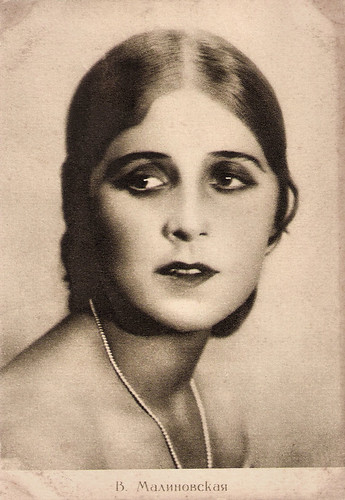
Russian postcard by Goziak, Moscow, series no. 4, no. A-2400, 1927. Published in an edition of 25,000 cards.
Vera Malinovskaya (1900-1988), also written as Malinovskaja or Malinovskaia, played in several Russian films of the 1920s and also in a few films in Germany and Austria. From 1925 on, she had leading roles in films by the Mezhrabpom film company, often playing innocent girls. In 1925 she played Dunia opposite Ivan Moskvin in Kollezhskiy registrator/The Station Master (Ivan Moskvin, Yuri Zhelyabuzhsky, 1925), scripted by Fyodor Otsep (Fedor Ozep), after a novel by Alexander Pushkin.

Russian postcard by Goziak, Moscow. Paul Richter in Pietro der Korsar/Peter the Pirate (Arthur Robison, 1925).
Austrian actor Paul Richter (1895-1961) starred in several silent films directed by Joe May and Fritz Lang. He became an idol of the 1920s with the lushly produced Ufa production Die Nibelungen (Fritz Lang, 1924).

Russian postcard by Goziak, Moscow, no. 2, 1927.
Yuliya Solntseva (1901–1989) was a Soviet film director and actress who starred as the Queen of Mars in the silent Sci-Fi classic Aelita (Yakov Protazanov, 1924) and as a cigarette girl in the romantic comedy Papirosnitsa ot Mosselproma/The Cigarette Girl of Mosselprom (Yuri Zhelyabuzhsky, 1924). Solntseva directed 14 films between 1939 and 1979. She was married to director Aleksandr Dovzhenko and collaborated with him on his later films, including Michurin (1949), for which she was awarded a Stalin Prize. For Povest plamennykh let/The Chronicle of Flaming Years (1961), she won the Best Director award at the 1961 Cannes Film Festival. She was named a People's Artist of the USSR when she turned 80.
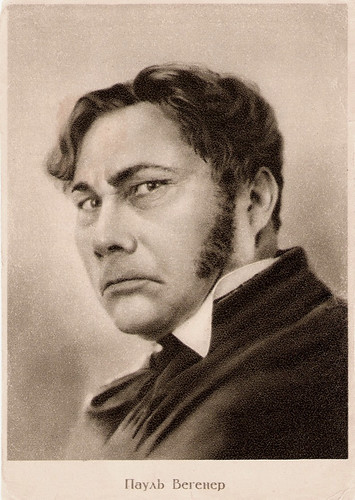
Russian postcard, no. 4, 1927.
German actor, writer, and film director Paul Wegener (1874-1948) is one of the true fathers of the horror and fantasy genre, particularly remembered for his three silent films centred around the Jewish legend of the Golem. Wegener was one of the pioneers of German cinema who realised the potential of the new medium and used the possibilities of cinematic trick photography as a method for presenting fantastic tales in a serious matter.
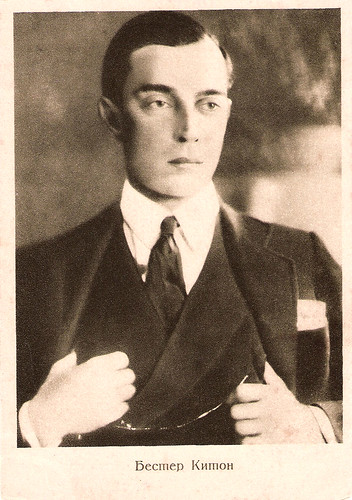
Russian postcard by Goziak, Moscow, no. 1725, 1927.
Stone-faced Buster Keaton (1895-1966) was one of the three greatest comedians of Silent Hollywood. His most enduring features include Our Hospitality (1923), The Navigator (1924), Sherlock Jr. (1924), College (1927), and The General (1927).
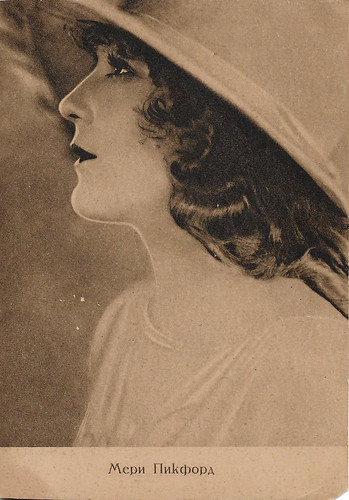
Russian postcard by Goziak, Moscow, no. A-11967, 1928. The card was issued in an edition of 25,000 copies.
Mary Pickford (1892-1979) was a legendary silent film actress and was known as 'America’s sweetheart'. She married Douglas Fairbanks, Sr. in 1920, becoming one of Hollywood’s earliest super couples. Fans adored the pairing, and the couple was mobbed at every port on their whirlwind European honeymoon. She scored box-office hits with Polyanna (1920), Little Lord Fauntleroy (1921), and Tess of the Storm Country (1922). She was a founder of United Artists and helped to establish the Academy.
The ideological and artistic needs of the proletariat
In 1924, filmmakers Sergei Eisenstein and Lev Kuleshov created the first association of Soviet filmmakers, the Association of Revolutionary Cinematography (ARK), to “meet the ideological and artistic needs of the proletariat”. Although state-controlled, the organisation was characterised by a pluralism of political and artistic views until the late 1920s.
One of the most iconic developments in film during this period that is still used in films today was editing and montage to create meaning. This style of filmmaking came to be known as 'the Kuleshov effect' and was employed to conserve film stock due to shortages during that period.
Innovation in Russian filmmaking was expressed particularly in the work of Eisenstein such as his films Bronenosets Potyomkin/Battleship Potemkin (1925) and Oktyabr': Desyat' dney kotorye potryasli mir/October: Ten Days That Shook the World (1928).
Also noteworthy was Vsevolod Pudovkin's adaptation of Maxim Gorky's Mat/Mother to the screen in 1926. Pudovkin developed themes of revolutionary history in the film Konets Sankt-Peterburga/The End of St. Petersburg (1927).
Other noteworthy silent films were films dealing with contemporary life such as Boris Barnet's Dom na Trubnoy/The House on Trubnaya (1928). The films of Yakov Protazanov were devoted to the revolutionary struggle and the shaping of a new way of life, such as Don Diego i Pelageya/Don Diego and Pelagia (1928).
And finally, the Ukrainian director Aleksandr Dovzhenko was noteworthy for the historical-revolutionary epic Arsenal (1929) and the poetic film Zemlya/Earth (1930).
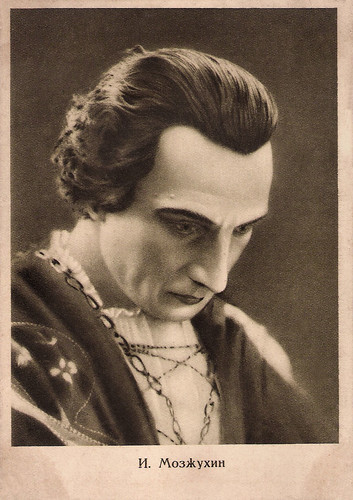
Russian postcard by Goziak, Moscow, series no. 5, no. A 4711, 1928. The card was issued in an edition of 25,000 copies. The price was 10 Kop. Photo: Ivan Mozzhukhin in Kean/Edmund Kean: Prince Among Lovers (Alexandre Volkoff, 1924).
Russian actor Ivan Mozzhukhin (1889-1939) was a legendary star of the European silent film. He escaped from execution by the Soviet Red Army and made a stellar career in Europe, but he suffered in Hollywood. He first starred in about thirty silent Russian films made by Pyotr Chardynin, Aleksandr Khanzhonkov, and Yevgeni Bauer. From 1915 to 1919 he worked in about 40 films by directors Yakov Protazanov and Viktor Tourjansky under the legendary Russian producer Joseph N. Ermolieff. After the Revolution, in 1920, he left Russia together with his wife Nathalie Lissenko and his partners from Ermolieff. They emigrated together to France and started in Paris a Russian-French film company. He starred in hits like the innovative murder mystery La maison du mystère/The Mysterious House (1923), Kean/Edmund Kean: Prince Among Lovers (1924), and the lavish adventure spectacle Michel Strogoff/Michael Strogoff (1926) based on the Jules Verne novel. Best remembered is the humourous and visually splendid epic Casanova/The Loves of Casanova (1927).
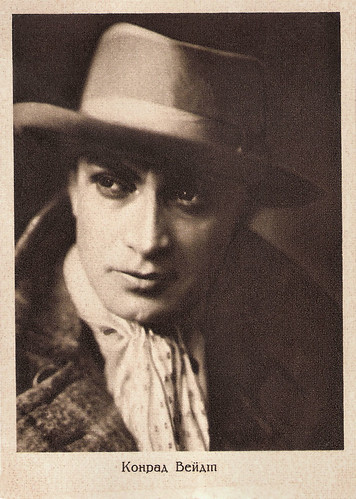
Russian postcard, no. 6, 1928.
Conrad Veidt (1893–1943) was the most highly strung and romantically handsome of the German expressionist actors. From 1916 until his death, he appeared in well over 100 films, including such classics as Das Kabinett des Dr. Caligari/Das Cabinet des Dr. Caligari (Robert Wiene, 1920) and Casablanca (Michael Curtiz, 1942).

Russian postcard by Goziak, Moscow, series no. 9, no. A-15639, 1928. The card was issued in an edition of 10,000 copies. The price was 10 Kop.
Anatoli Ktorov (1898-1980) was a brilliant Soviet and Russian film and stage actor who was stuttering in real life but was perfectly eloquent in acting roles. He had a career spanning from silent films Yakov Protazanov to the Oscar-winning epic Voyna i mir/War and Peace (1965-1967). He became a People's Artist of the USSR in 1963.

Russian postcard by Goziak, Moscow, series no. 8, no. A-16279, 1928. The card was issued in an edition of 30,000 copies. The price was 10 Kop.
Russian actor Sergei Minin (1901-1937) was a star of the Soviet cinema of the 1920s. He worked with such famous directors as Abram Room and Ilya Trauberg.

Russian postcard by Goziak, Moscow, series no. 5, no. A-47112, 1928. The card was issued in an edition of 25,000 copies. The price was 10 Kop.
Ukrainian actor Vladimir Gajdarov (1893-1976) (aka Wladimir Gaidarow and Vladimir Gaidaroff) was a popular star in the European silent cinema. He began his film career in Russia before the October Revolution. Later he became a popular star in the German and French silent cinema. The sound film made him return to his home country, but in the Soviet Union, he had a hard time getting work.
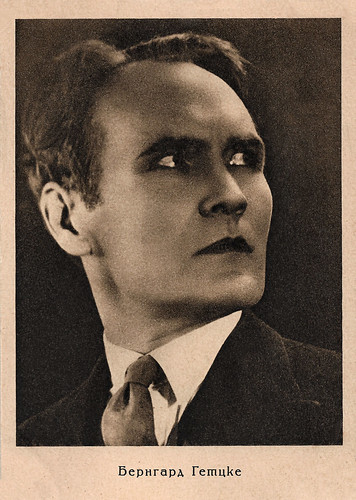
Russian postcard by Goziak, Moscow, series no. 14, no. A 29871, 1929. The card was issued in an edition of 15,000 copies. The price was 10 Kop.
German film actor Bernhard Goetzke (1884-1964) was one of the impressive stars of the silent films by Fritz Lang. He appeared in 130 films between 1917 and 1961.

Russian postcard by Goziak, Moscow.
Vera Malinovskaya (1900-1988), also written as Malinovskaja/Malinovskaia, played in several Russian films of the 1920s and a few in Germany and Austria.
Sources: Wikipedia and IMDb.
This post was last updated on 27 May 2022.
No comments:
Post a Comment